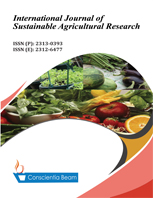Preliminary Assessment of Bambara Groudnutnut [Vigna Subterranea (L.) Verdc.] Landraces for Incidence of Pre-Emergence Damping-Off Disease and Yield under Irrigated and Rain-Fed Conditions
DOI:
https://doi.org/10.18488/ijsar.v9i2.2974Abstract
Fusarium oxysporum attacks Bambara groundnut at all stages of development. Attack prior to seed germination results in pre-emergence damping-off disease that can lead to losses in crop stands which eventually reduce crop yield. Dry and wet season field trials were conducted to evaluate the effect of incidence of the disease on yield of Bambara nut landraces in Maiduguri, northeastern Nigeria. Three Bambara nut landraces (Cream, Red and Black) were laid out in Randomized Complete Block Design replicated three times in each season. Significant (P≤0.05) differences were observed among the landraces in respect of percentage seed germination, seedling emergence, disease incidence and pod yield. Seed germination ranged from 68.9 - 80.0 %. Field emergence test taken from the average of the two seasons ranged from 40.4 – 72.3 %. Mean across the seasons showed that Black had the highest (72.3) percent emerged seedlings, lowest (26.7 %) disease incidence and highest pod yield of 207.2 kg/ha. While Cream had the highest (65) percent disease incidence, the lowest (40.4) percent emerged seedlings and lowest pod yield of 76.6 kg/ha. Cream is the most popular choice of the farmers and consumers, and coincidentally the most susceptible among the landraces. Low disease incidence in the wet season did not result in higher pod yield due to end of season drought. With uncertainty/variability of rainfall pattern in the region, dry season is the second best option for planting the crop.

